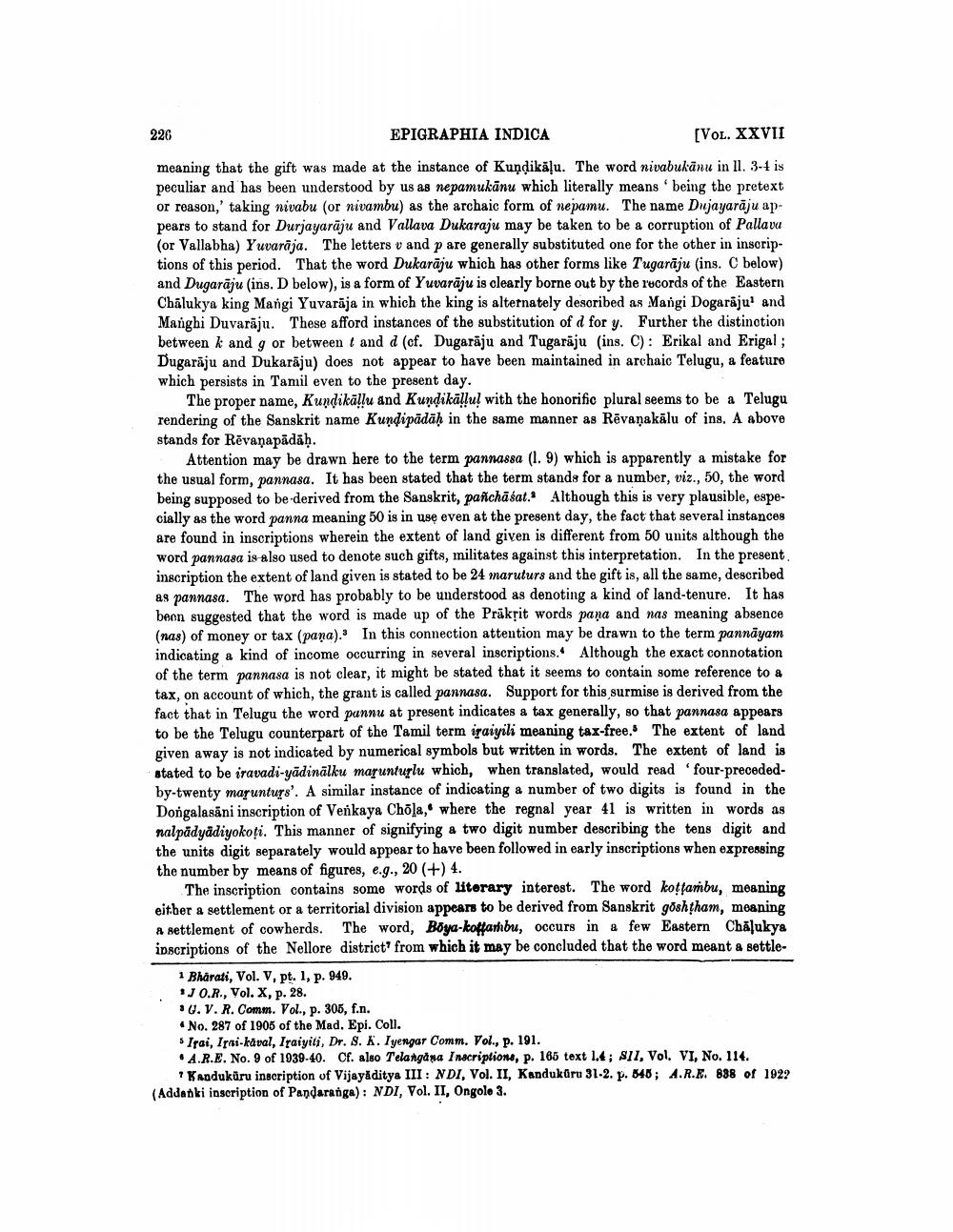________________
226 EPIGRAPHIA INDICA
[VOL. XXVII meaning that the gift was made at the instance of Kundikāļu. The word nivabukānu in 11. 3-4 is peculiar and has been understood by us as nepamukānu which literally means 'being the pretext or reason,' taking nivabu (or nivambu) as the archaic form of nepamu. The name Dujayarāju appears to stand for Durjayarāju and Vallava Dukaraju may be taken to be a corruption of Pallava (or Vallabha) Yuvarāja. The letters v and p are generally substituted one for the other in inscriptions of this period. That the word Dukarāju which has other forms like Tugarāju (ins. C below) and Dugarāju (ins. D below), is a form of Yuvarāju is clearly borne out by the records of the Eastern Chalukya king Mangi Yuvarija in which the king is alternately described as Mangi Dogarajul and Manghi Duvarāju. These afford instances of the substitution of d for y. Further the distinction between k and g or between t and d (cf. Dugarāju and Tugarāju (ins. C): Erikal and Erigal; Dugarāju and Dukarāju) does not appear to have been maintained in archaic Telugu, a feature which persists in Tamil even to the present day.
The proper name, Kundikāllu and Kundikāllul with the honorific plural seems to be a Telugu rendering of the Sanskrit name Kundipādāḥ in the same manner as Rēvanakālu of ins. A above stands for Rēvanapādāḥ.
Attention may be drawn here to the term pannassa (l. 9) which is apparently a mistake for the usual form, pannasa. It has been stated that the term stands for a number, viz., 50, the word being supposed to be derived from the Sanskrit, panchasat. Although this is very plausible, especially as the word panna meaning 50 is in use even at the present day, the fact that several instances are found in inscriptions wherein the extent of land given is different from 50 units although the word pannasa is also used to denote such gifts, militates against this interpretation. In the present. inscription the extent of land given is stated to be 24 maruturs and the gift is, all the same, described as pannasa. The word has probably to be understood as denoting a kind of land-tenure. It has been suggested that the word is made up of the Präksit words paņa and nas meaning absence (nas) of money or tax (pana). In this connection attention may be drawn to the term pannäyam indicating a kind of income occurring in several inscriptions. Although the exact connotation of the term pannasa is not clear, it might be stated that it seems to contain some reference to a tax, on account of which, the grant is called pannasa. Support for this surmise is derived from the fact that in Telugu the word pannu at present indicates a tax generally, so that pannasa appears to be the Telugu counterpart of the Tamil term iraiyili meaning tax-free. The extent of land given away is not indicated by numerical symbols but written in words. The extent of land is stated to be iravadi-yādinālku marunturlu which, when translated, would read 'four-precededby-twenty marunturs'. A similar instance of indicating a number of two digits is found in the Dongalasäni inscription of Venkaya Chola, where the regnal year 41 is written in words as nalpädyādiyokoţi. This manner of signifying a two digit number describing the tens digit and the units digit separately would appear to have been followed in early inscriptions when expressing the number by means of figures, e.g., 20 (+) 4.
The inscription contains some words of literary interest. The word kotfambu, meaning either a settlement or a territorial division appears to be derived from Sanskrit goshtham, meaning a settlement of cowherds. The word, Boya-koffarbu, occurs in a few Eastern Chalukya inscriptions of the Nellore district' from which it may be concluded that the word meant a settle
1 Bharati, Vol. V, pt. 1, p. 949. 1J O.R., Vol. X, p. 28. *U. V. R. Comm. Vol., p. 305, f.n.
No. 287 of 1905 of the Mad. Epi. Coll. Irai, Irai-kaval, Iraiyili, Dr. 8. K. Iyengar Comm. Vol., p. 191. .A.R.E. No. 9 of 1939-40. Cf. also Telangana Inscriptions, p. 165 text 14; SII, Vol. VI, No. 114.
* Kandukuru inscription of Vijayaditya III: NDI, Vol. II, Kandukuru 31-2. p. 548; A.R.E. 888 of 1929 (Addonki inscription of Pandaranga): NDI, Vol. II, Ongole 3.




